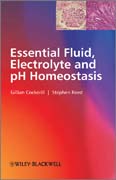
This textbook provides a unique, pocket-sized, self-directed study guide to fluid, electrolyte and acid base homeostasis for undergraduate biomedical science, pharmacology, medical and allied health students. It details the chemical (mostly ionic) composition of body fluids, explains how abnormalities arise, what laboratory tests can be used to identify and analyze the cause of these disorders and shows how normality can be achieved to maintain health. INDICE: List of figures xiii List of tables xvii Preface xix Acknowledgements xxi Part 1: Background theory and basic concepts. Section 1.i Introductionand overview 3 Section 1.ii Water 8 Section 1.iii Solutions: concentrations and colligative properties of solutes 12 Section 1.iv Self-assessment exercise 1.1 16 Section 1.v Acids and bases 18 Section 1.vi Buffers and the Henderson-Hasselbalch equation 23 Section 1.vii Self-assessment exercise 1.2 26 Section 1.viii Body fluids and their composition: overview 28 Section 1.ix Fluid balance: (a) between fluid compartments and (b) intake and loss 34 Section 1.x Ioniccomposition and electrical neutrality 39 Section 1.xi Water and ion distribution between compartments 1: Physical chemistry 43 Section 1.xii Water and ion distribution between compartments 2: Physiology 50 Section 1.xiii Osmoregulation: solvent and solute balance 55 Section 1.xiv Self-assessment exercise 1.3 60 Section 1.xv Summary of Part 1 62 Answers to Part 1 self-assessment exercises 63 Part 2: Fluid and electrolyte homeostasis. Normal physiology Section 2.i Fluid translocation: plasma to ISF and ISF to ICF 83 Section 2.ii Renal function: a brief overview 88 Section 2.iii Renal regulation of blood composition 93Section 2.iv Self-assessment exercise 2.1 100 Section 2.v Minerals: key rolesin physiology and metabolism 102 Section 2.vi Sodium and potassium 106 Section 2.vii Sodium and water homeostasis: renal regulation of blood pressure and blood volume 109 Section 2.viii Calcium and magnesium 115 Section 2.ix Iron 123Section 2.x Selected trace elements: Mn, Co, Se and S 128 Section 2.xi Anions: bicarbonate, chloride, phosphate and proteins 130 Section 2.xii Self-assessment exercise 2.2 132 Section 2.xiii Laboratory measurements 1: Osmometry 134 Section 2.xiv Laboratory measurements 2: Ion selective electrodes (ISEs) 138 Section 2.xv Laboratory measurements 3: Calcium, magnesium, vitamin D, phosphateand iron 147 Section 2.xvi Laboratory measurements 4: Miscellaneous methods for clinically useful analytes 150 Section 2.xvii Self-assessment exercise 2.3 154 Disorders of fluid and electrolyte balance Section 2.xviii Introduction 157 Section 2.xix Principles of data interpretation 160 Section 2.xx Sodium, protein and water 167 Section 2.xxi Hypernatraemia 173 Section 2.xxii Hyponatraemia 179 Section 2.xxiii Disturbances of potassium homeostasis 184 Section 2.xxiv Hyperkalaemia 186 Section 2.xxv Hypokalaemia 189 Section 2.xxvi Disturbancesof calcium or magnesium balance 193 Section 2.xxvii Disorders of iron homeostasis 200 Section 2.xxviii Self-assessment exercise 2.4 202 Section 2.xxix Summary of Part 2 207 Answers to Part 2 self-assessment exercises 209 Part 3: Acid-base homeostasis. Normal physiological processes Section 3.i Acidity, pH and buffers: recap of some basic chemistry 221 Section 3.ii Some worked example calculations 224 Section 3.iii Self-assessment exercise 3.1 227 Section 3.iv Homeostasis and the 'daily acid challenge' 228 S
- ISBN: 978-0-470-68306-4
- Editorial: John Wiley & Sons
- Encuadernacion: Rústica
- Páginas: 360
- Fecha Publicación: 16/09/2011
- Nº Volúmenes: 1
- Idioma: Inglés
